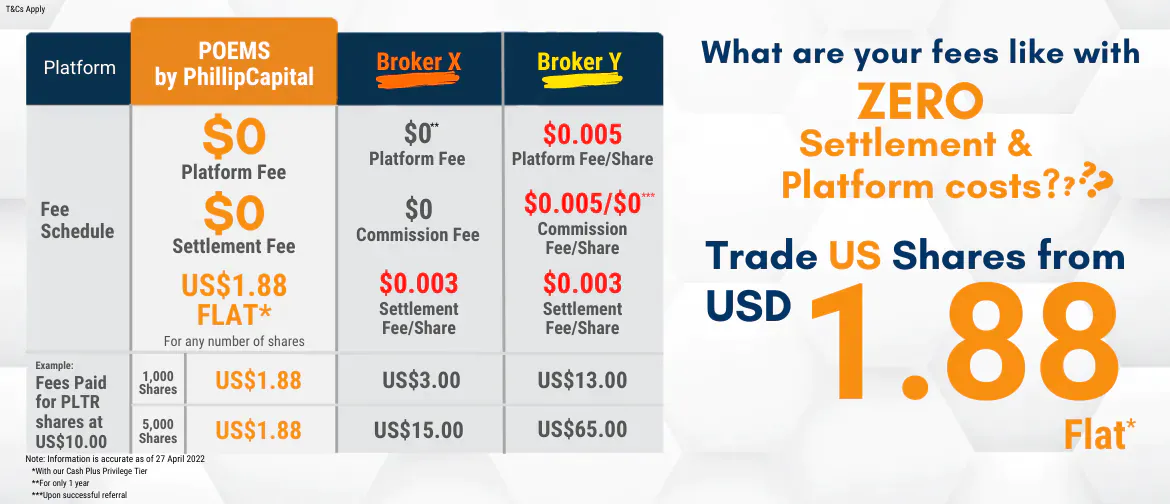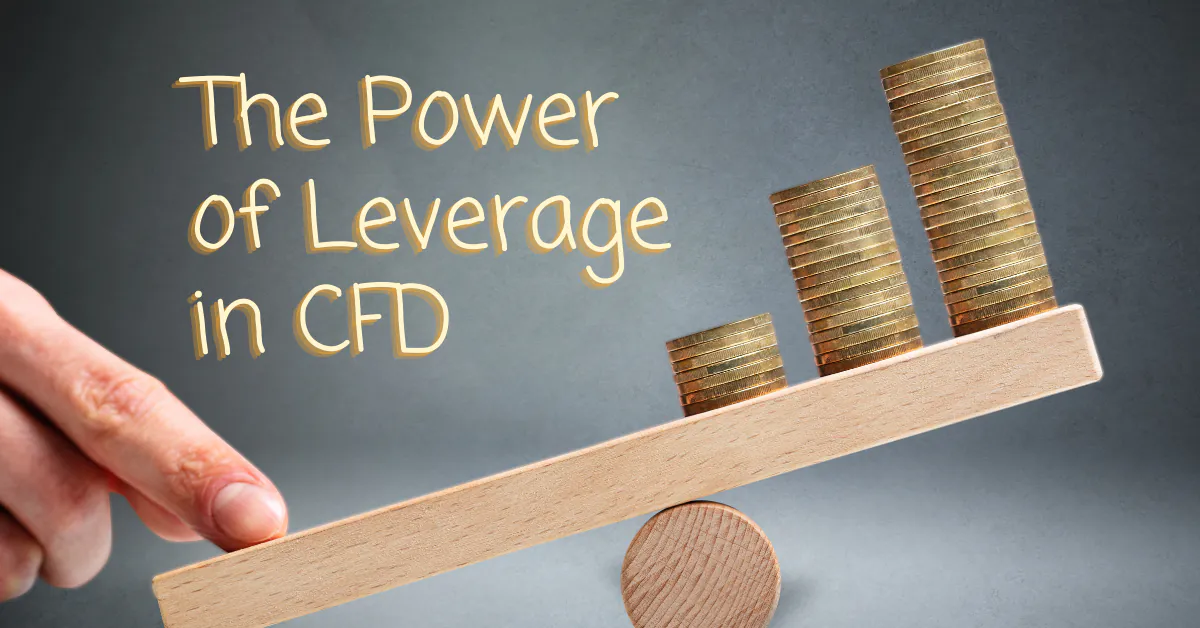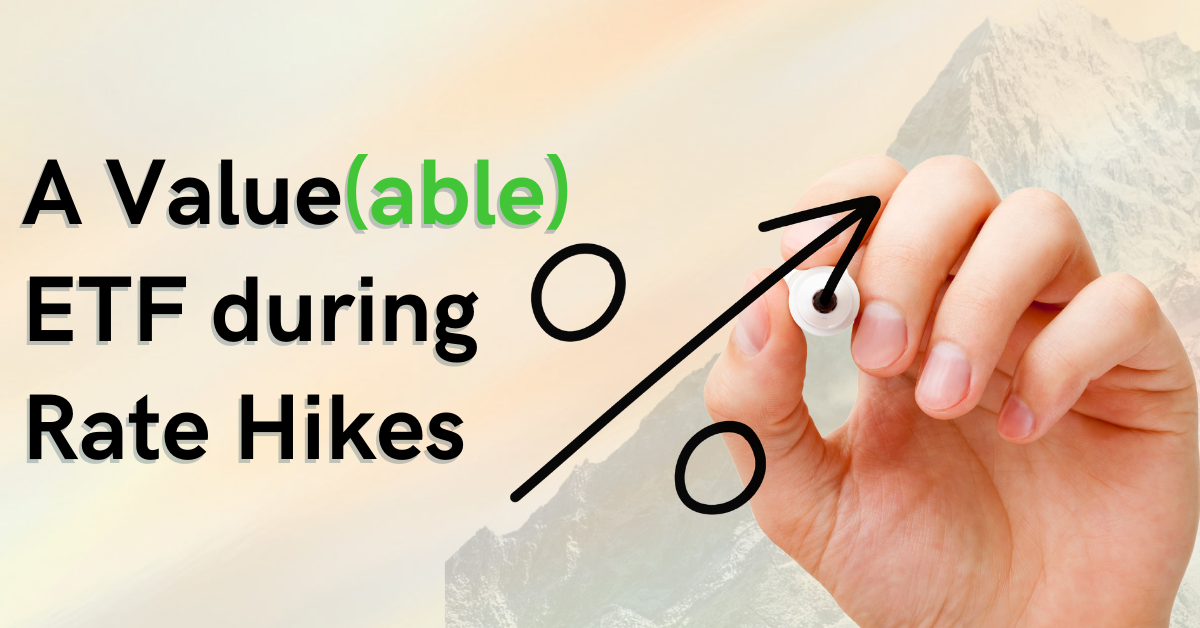Exploring the Rise and Fall of the Japanese Yen (JPY) Through Time
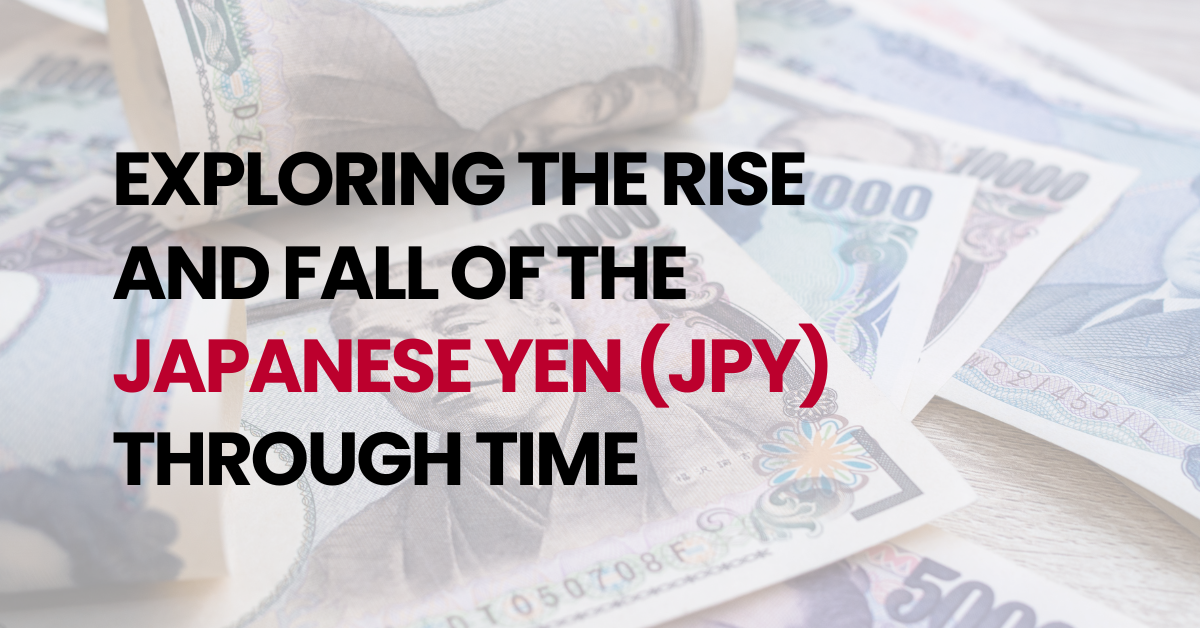
Yeo Sze Han, Assistant Manager
Yeo Sze Han graduated from the National University of Singapore with a BSc (Hons) degree in Science. He has passed the Chartered Financial Analyst (CFA) level 1 examination and likes reading up on stock market news and updates.
Sze Han likes to incorporate fundamental and technical analysis when advising clients on stocks, ETFs and CFDs.
The Japanese Yen (JPY) has long been considered a safe-haven currency due to Japan’s strong global standing and its reputation as a stable, developed, and open economy.
With its unique profile as the de facto “go-to” currency in times of uncertainties, the JPY features heavily in global Forex (FX) trading. The USDJPY, EURJPY and GBPJPY for example, are three of the most actively monitored and traded currency pairs around the world, and the SGDJPY is also popular especially among Singaporean FX traders.
Due to historical developments and geopolitical reasons, the USDJPY, EURJPY and GBPJPY pairs have long and established FX trading records stretching back to the 1970s. Before that, the JPY was subject to fixed exchange rates under the Bretton Woods system which was established after WWII.
Comparatively, the trading of SGDJPY as a currency pair only gained global interest and prominence around the 1980s to 1990s, after Singapore had settled in as an independent country and established itself as a major financial centre in Asia.
To understand the current positioning of the JPY within the global landscape, why trading volume has doubled in the last 12 months, and the potential direction that the JPY may be headed next, we need to trace back in time and explore how the JPY has featured at various notable moments in history.
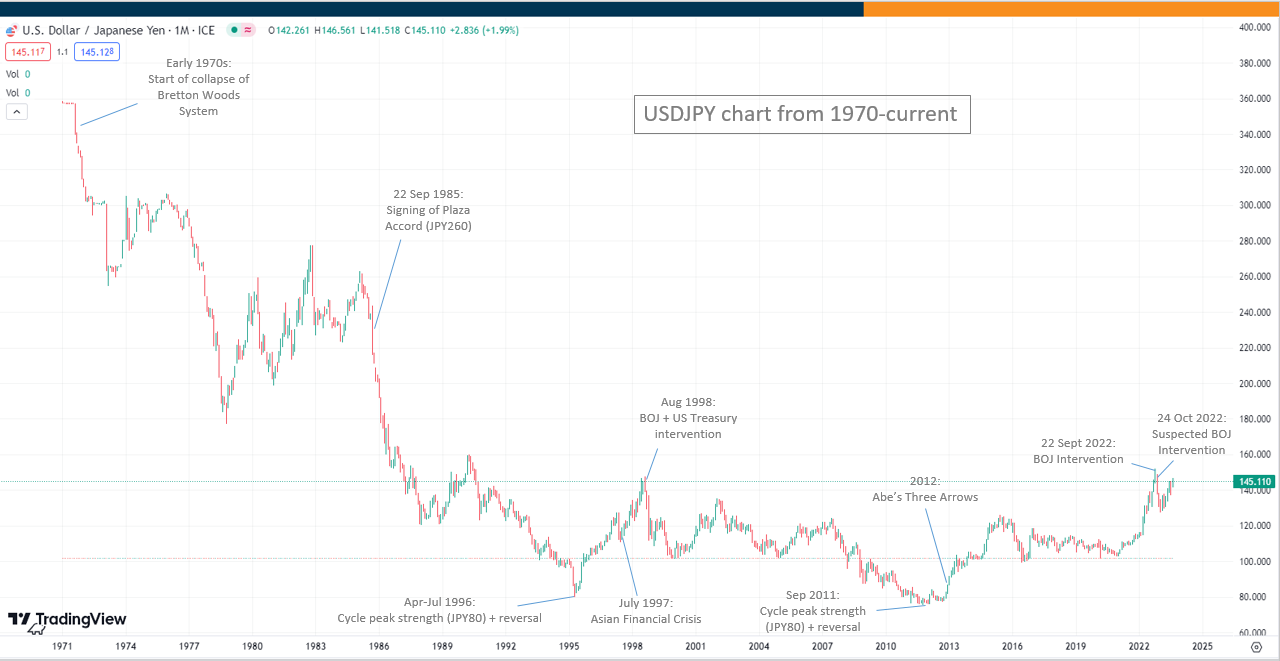
USDJPY chart, from 1970-current (Source: tradingview.com)
The Plaza Accord and Japan’s Asset Bubble (1980s-1990s)
In the 1970s and 1980s, the US was besieged by a 10-15 year period of high inflation that reached heights of 20%. At the same time, US exports were suffering due to the strength of the US dollar, causing a recession in the US and also threatened to drag down other major economies.
To avert a potential global catastrophe, the G5 nations of the US, the UK, West Germany, France and Japan came together and collectively signed the Plaza Accord in September 1985 to intervene in the forex markets. This concerted effort of the Big 5 was successful in devaluing the USD, but it also led to a substantial and uncontrollable rise in the value of the JPY over the next decade. From 1985 to 1995, the JPY rode a steep ascent from JPY260 to JPY80 against the dollar, strengthening by more than 300% within a decade.
This rapid rise of the JPY fueled the development of a massive speculative bubble in Japan. Within a short span of five years, Japan’s real estate market and stock market tripled in value. When the bubble burst in 1990, the fallout on the Japanese economy was devastating. Japan fell quickly into a deep recession, followed by more than 10 years of deflation and sluggish economic growth in a period that is now commonly referred to as the “Lost Decade” of Japan.
Asian Financial Crisis (1997-1998)
From 1995, the JPY started to weaken due to the combined effects of excessive strengthening in the prior years, and as a market expression of the fundamental weakness in Japan’s economy. Although Japan’s stagnant economy did begin to show signs of revival around this time, the recovery was short-lived.
This was because shortly after 2 July 1997 when the Asian Financial Crisis struck the region, swiftly claiming the Thai Baht as its first victim and then moving on to attack other Asian currencies, which fell one after another. Confidence in the Asian market currencies eroded quickly. The JPY, like all other currencies in Asia, suffered the effects of the mass market sell-offs that followed, plummeting by 26% in the 12 months after.
Japan and US Government Interventions in 1998
To curb further weakening of the JPY in the aftermath of the Asian Financial Crisis and to restore confidence and calm back to the region, the Bank of Japan (BOJ), together with the US Treasury Department, stepped in in 1998 to help prop up the JPY.
By August 1998, after sliding to a low of JPY145 against the dollar, the JPY halted its drop and recovery began. Market confidence in the JPY returned gradually, and the currency eventually traded back to around JPY102 to the dollar by February 2000.
Global Financial Crisis (2007-2008)
After its recovery from the Asian Financial Crisis, the JPY continued to play a pivotal role in international forex markets, providing stability during periods of global uncertainties.
In 2007 for example, during the Global Financial Crisis when financial markets were in chaos, traders piled money into the safe harbour of the JPY to seek out shelter. The JPY strengthened by 20% in the period from 2007-2011.
Abenomics, QQE and NIRP (2012-2020)
In 2012, Shinzo Abe became the Prime Minister of Japan and, during his tenure, he launched a set of economic policy packages known collectively as the “Three Arrows,” with the goal of breaking Japan out of a cycle of deflation and weak economic growth.
As part of monetary reforms during Abenomics (economic policies set out under PM Shinzo Abe), the BOJ undertook massive monetary easing, which included aggressive purchases of Japanese Government Bonds (JGBs) and other financial assets through Quantitative and Qualitative Monetary Easing (QQE).
When QQE failed to lift inflation in Japan sustainably toward its 2% long term target, the BOJ followed up with Negative Interest Rate Policy (NIRP) in January 2016 and then Yield Curve Control (YCC) in September 2016 to stimulate economic activities.
The negative interest rate stature of the JPY makes the currency a standard feature in carry-trade strategies, as traders can borrow in JPY at little to no cost and then use the borrowed funds to invest in higher-yielding assets elsewhere.
Covid, inflation and BOJ policy divergence
When Covid hit in 2019, the whole world went into synchronised lockdown for the first time in human history. People stayed indoors and all economic activities came to a standstill. Governments issued funds to help cushion the effects of income losses, but goods were in limited supply due to disruptions and bottlenecks in supply chains. The resulting imbalance in supply-and-demand dynamics created tremendous upward price pressures and led to a resurgence of 40-year-high inflation rates globally.
While central banks around the world were hiking interest rates furiously to tamp down inflation, the BOJ remained unmoved by the clamour, preferring instead to stick unwaveringly to its policy of negative interest rates, because unlike situations in many other parts of the world, the inflation and wage growth profiles in Japan had remained at relatively benign levels.
This divergence in interest rate policies, coupled with lack of government interference in the currency markets, led to a quick weakening of the JPY against the USD, EUR, GBP and SGD, and was one of the main reasons for the surge in trading volumes of JPY-related currency pairs in the last 16 months.
Factors affecting JPY in the coming months
The USDJPY is currently trading near a psychologically important benchmark of 145, similar to levels reached in August 2022 and in August 1998, both of which as a result of the BOJ’s intervention in the FX markets to bolster support for the currency.
Market attention has also been focused on Kazuo Ueda since he took over as the new Governor of the BOJ on 10 April 2023, for clues on whether there are plans to end an era of ultra-accommodative policies set in place by his predecessor.
Traders of USDJPY, GBPJPY, EURJPY and SGDJPY currency pairs are keenly following the comments and actions of the central banks of the US, UK, EU and Singapore for indications of the direction that interest rate policies in these regions may take in the coming months.
Latest data from the US, UK, EU and SG however, continue to suggest that inflation, especially core inflation, remains relatively sticky.
For now, traders yearning for a reversal of the weakness in the JPY may just have to be patient, as the unwinding of the trade play of the last 16 months on interest rate differentials may still require more time to work itself out.
How to get started with POEMS
As the pioneer of Singapore’s online trading, POEMS’s award-winning suite of trading platforms offers investors and traders more than 40,000 financial products across global exchanges.
Explore an array of US shares with brokerage fees as low as US$1.88 flat* when you open a Cash Plus Account with us today. Find out more here (terms and conditions apply).
We hope that you have found value reading this article. If you do not have a POEMS account, you may visit here to open one with us today.
Lastly, investing in a community is much more fun. You will get to interact with us and other seasoned investors who are generous in sharing their experience and expertise.
In this community, you will be exposed to quality educational materials, stock analysis to help you apply the concepts, unwrap the mindset of seasoned investors, and even post questions.
We look forward to sharing more insights with you in our growing and enthusiastic Telegram community. Join us now!
For enquiries, please email us at cfd@phillip.com.sg.
Promotions

Earn up to S$360 cash credits when you trade FX CFDs!
From 3 July to 29 September 2023, enjoy up to S$120 cash credits every month and earn up to S$360 cash credits when you trade FX CFDs on POEMS for 3 consecutive months (July, August and September).
*T&Cs Apply.
For more information, click here.
References
[1] https://www.investopedia.com/articles/trading/04/042104.asp
[2] https://www.babypips.com/learn/forex/summary-developing-a-trading-plan
[3] https://www.babypips.com/learn/forex/mechanical-trading-systems
[4] https://www.dailyfx.com/education/find-your-trading-style/trading-plan.html
[5] https://bookmap.com/blog/how-to-create-a-trading-plan/
[6] https://www.phillipcfd.com/what-is-fx-cfd-why-you-should-trade-them/
More Articles
The Power of Leverage in CFD
What is leverage? Read our article to find out more about the different uses of leverage through the use of Contract for Differences (CFDs) for both traders and long-term investors.
Why You Should Consider Dividend Investing
Have you tried dividend investing? Learn more about why you should consider dividend investing!
A Value(able) ETF During Rate Hikes
Interested in buying valuable ETFs? Read on our article to find out more!
Disclaimer
This material is provided to you for general information only and does not constitute a recommendation, an offer or solicitation to buy or sell the investment product mentioned. It does not have any regard to your specific investment objectives, financial situation or any of your particular needs. Accordingly, no warranty whatsoever is given and not liability whatsoever is accepted for any loss arising whether directly or indirectly as a result of your acting based on this information.
Investments are subject to investment risks. The risk of loss in leveraged trading can be substantial. You may sustain losses in excess of your initial funds and may be called upon to deposit additional margin funds at short notice. If the required funds are not provided within the prescribed time, your positions may be liquidated. The resulting deficits in your account are subject to penalty charges. The value of investments denominated in foreign currencies may diminish or increase due to changes in the rates of exchange. You should also be aware of the commissions and finance costs involved in trading leveraged products. This product may not be suitable for clients whose investment objective is preservation of capital and/or whose risk tolerance is low. Clients are advised to understand the nature and risks involved in margin trading.
You may wish to obtain advice from a qualified financial adviser, pursuant to a separate engagement, before making a commitment to purchase any of the investment products mentioned herein. In the event that you choose not to obtain advice from a qualified financial adviser, you should assess and consider whether the investment product is suitable for you before proceeding to invest and we do not offer any advice in this regard unless mandated to do so by way of a separate engagement. You are advised to read the trading account Terms & Conditions and Risk Disclosure Statement (available online at www.poems.com.sg) before trading in this product.
Any CFD offered is not approved or endorsed by the issuer or originator of the underlying securities and the issuer or originator is not privy to the CFD contract. This advertisement has not been reviewed by the Monetary Authority of Singapore (MAS).





